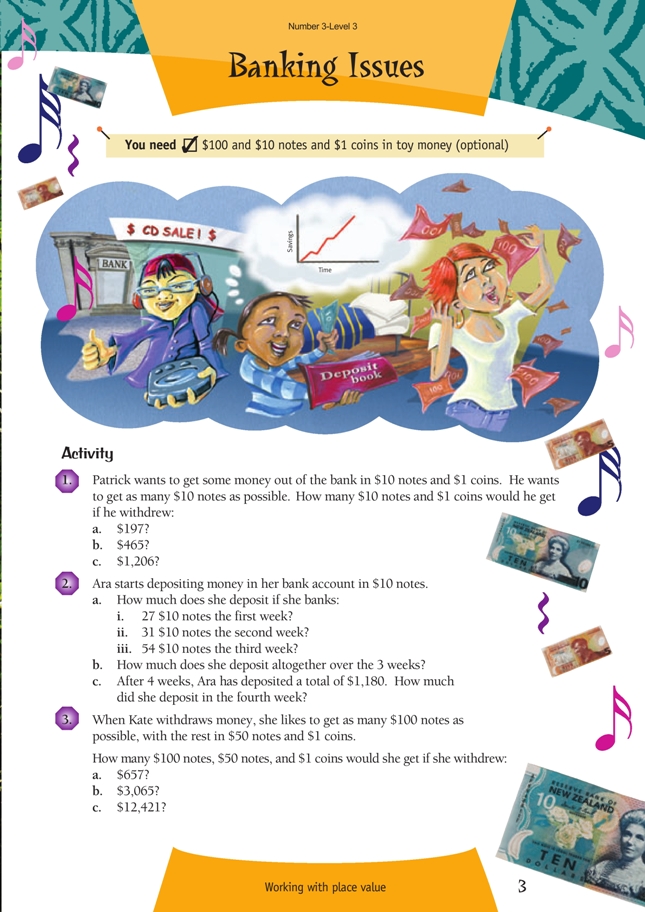This is a level 3 number activity from the Figure It Out series. It relates to Stage 6 of the Number Framework.
A PDF of the student activity is included.
Click on the image to enlarge it. Click again to close. Download PDF (284 KB)
find the number of ones, tens, hundreds in numbers
$100 and $10 notes and $1 coins in toy money (optional)
To do this activity, students need to be able to recognise money denominations. They also need to be able to count in tens, hundreds, and thousands and to multiply by tens and hundreds.
Most students will be able to recognise the notes and coins, but they may not know the number of tens, hundreds, and so on in the various amounts. To help them understand this, use a place value chart so that the students can read the values of the notes and amounts.
To do the questions, the students need to be able to recognise the number of ones, tens, and hundreds in a dollar value such as $178. (Note that 1 hundred, 7 tens, and 8 ones can also be seen as 17 tens and 8 ones or 178 ones.) Some students may have difficulty with this concept. It is not necessary to introduce traditional names such as “face, place, and total value” because the activity only requires the students to understand the total number of tens, hundreds, thousands, and so on.
Encourage the students to use toy money to model the amounts until they see the pattern in the numbers. For example, $197 has 19 tens (and 7 ones).
Show the students how the numbers move on the place value chart when they multiply and divide by 10. For example, when they are multiplying 24 by 10, the 24 moves one place to the left to become 240.
Many students are confused about multiplying and dividing by 10 and think that it’s simply a case of “adding a 0 or taking a 0 off”. Challenge this language by asking them to add 0 to 24. The answer, of course, is 24. Similarly, if they take 0 from 240, the answer is still 240. The digits remain where they are. The students who understand this concept will say “Because the digits have moved 1 place to the left, we put a 0 in the vacant ones place.”
This effect can be shown powerfully on a calculator when the students enter 10 x 24 and watch the display as they press the equals button. They can then use the constant function to multiply by 10 repeatedly by pressing = a number of times and watch the digits move one place to the left each time. (On some calculators, the students will need to enter 10 x x 24 before they can use the constant function.)
You may wish to extend this concept to multiplying by a factor of 100 or 1 000.
Question 1 asks the students to find the numbers of notes and coins in a given total. In question 2, the students multiply by 10 and then add and subtract the totals, and in question 3, they divide the values into hundreds, fifties, and ones.
Further discussion and investigation
Have the students relate the place-value concepts to other metric measures, such as the number of grams in a kilogram.
In pairs or small groups, the students could find large numbers mentioned in newspaper and magazine articles or advertisements and discuss the number of tens, hundreds, and so on in each number.
The students could investigate how many ones, tens, and so on there are in 1 million.
An interesting investigation could be to research how money developed. The students could also find out why New Zealand changed from the British system of pounds, shillings, and pence (£, s, and d) to decimal currency. They could discuss what benefits and/or disadvantages the introduction of decimal currency has brought.
Answers to Activity
1. a. 19 $10 notes and 7 $1 coins
b. 46 $10 notes and 5 $1 coins
c. 120 $10 notes and 6 $1 coins
2. a. i. $270
ii. $310
iii. $540
b. $1,120
c. $60
3. a. 6 $100 notes, 1 $50 note, 7 $1 coins
b. 30 $100 notes, 1 $50 note, 15 $1 coins
c. 124 $100 notes, 0 $50 notes, 21 $1 coins

